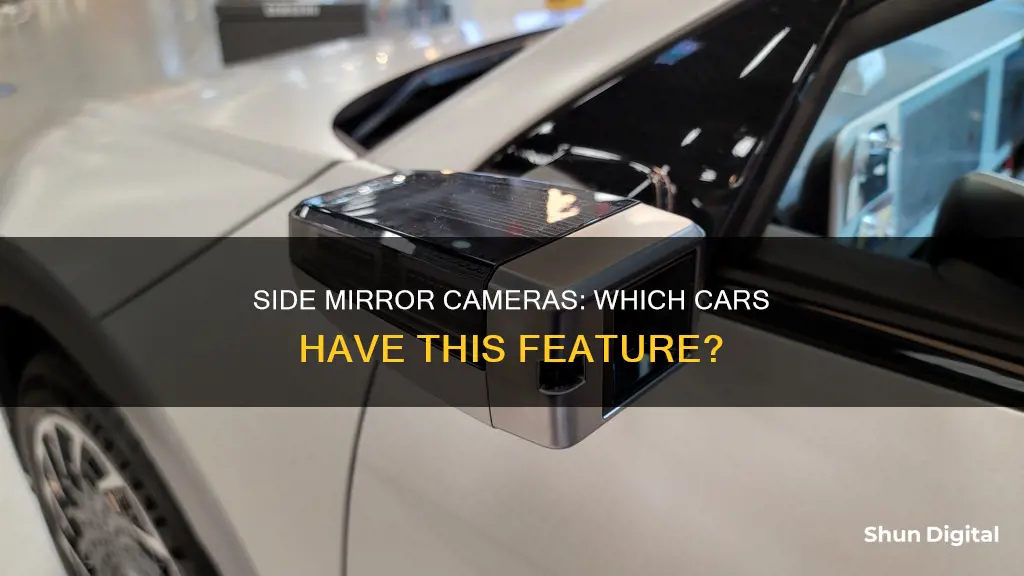
Replacing side mirrors with cameras is an emerging trend in car design. While it is not yet street legal in the US, several car manufacturers outside the US have already implemented this technology, including Audi, Honda, Hyundai, and Lexus. The benefits of mirror cameras include improved aerodynamics, reduced wind noise, better fuel efficiency, elimination of blind spots, and enhanced detail in dark or low-visibility conditions. However, there are also drawbacks, such as higher cost, increased complexity, and the potential for grainy or blurry footage. Ultimately, the adoption of mirror cameras in the US will depend on the results of safety testing and regulatory changes.
| Characteristics | Values |
|---|---|
| Car models | Audi e-tron, Honda E, Hyundai Ioniq 5, Honda Civic, Volkswagen XL1, Lexus ES, McLaren Speedtail |
| Advantages | Better aerodynamics, less wind noise, improved efficiency and range, elimination of blind spots, improved detail in dark places or bad weather, more minimalistic and futuristic look |
| Disadvantages | More expensive to buy and replace, more complex and prone to malfunction, grainy or blurry footage, display placement inside the vehicle, inconvenient for drivers with poor eyesight |
| US regulations | Cameras are not street legal in the US, but this may change as the NHTSA is considering a policy change |
What You'll Learn

Side mirror cameras improve efficiency and range
Side mirror cameras are becoming an increasingly popular feature in modern car design. Models such as the Audi e-tron, Honda E, and Hyundai Ioniq 5 have already adopted this technology. While they are not yet street legal in the US, they are permitted in the European Union, and manufacturers such as Tesla are keen to adopt them more widely.
Side mirror cameras offer a host of benefits that improve efficiency and range. Firstly, they improve a vehicle's aerodynamics by reducing drag. Traditional side mirrors create airflow separation, causing a pressure difference that results in pressure drag. By replacing side mirrors with cameras, the frontal area is reduced, leading to a decrease in aerodynamic drag and an improvement in fuel efficiency. This is especially beneficial for electric vehicles (EVs) where range is a critical factor. Audi claims that their e-tron model achieves a drag coefficient of 0.27 with virtual exterior mirrors, compared to 0.28 with conventional mirrors. This reduction in drag can increase the range by around 35 kilometres per battery charge.
In addition to improved aerodynamics, side mirror cameras also reduce wind noise. The compact design of cameras means there is less protrusion, resulting in a quieter cabin, which is an important factor for driver comfort. Furthermore, side mirror cameras eliminate blind spots by utilising wide-angle lenses that provide a broader field of view. This enhances safety and improves the overall driving experience.
Another advantage of side mirror cameras is their ability to enhance visibility in low-light conditions, such as driving through tunnels or parking at night. The exposure, ISO levels, and white balance of the cameras can be adjusted to provide a clearer view, whereas traditional mirrors rely solely on ambient lighting. This adaptability of side mirror cameras ensures a more detailed and illuminated image, making it easier for drivers to navigate in dark environments.
While side mirror cameras offer improved efficiency and range, it is important to acknowledge some potential drawbacks. Side mirror cameras are more expensive to purchase and replace than traditional mirrors. They are also more complex, which may lead to a higher likelihood of malfunction. Additionally, the display placement of the camera feed inside the vehicle can be a distraction for drivers, especially if the brightness levels are not appropriately adjusted for different driving conditions.
In conclusion, side mirror cameras offer significant advantages in terms of improved aerodynamics, reduced wind noise, elimination of blind spots, and enhanced visibility in low-light conditions. These benefits contribute to increased efficiency and range, making them a desirable feature for modern vehicles, particularly EVs. However, it is essential to carefully consider the potential drawbacks and ensure that any implementation prioritises safety and driver comfort.
Fight Camera Tickets: Ohio's Legal Options for Drivers
You may want to see also

They eliminate blind spots
Side mirror cameras are becoming an increasingly popular feature in modern car design, with manufacturers such as Honda and Hyundai leading the way. One of the key advantages of mirror cameras is the elimination of blind spots, which are perhaps the biggest hazard when it comes to side mirrors.
Cameras have wide-angle lenses that provide a much better view of the road behind, addressing the main issue with traditional side mirrors. Blind spots can be dangerous, especially when changing lanes or merging into traffic, as they can lead to collisions with vehicles or pedestrians that were not visible in the driver's field of vision.
The Society of Automotive Engineers (SAE) has recommended a method for aligning rear-vision and side-vision mirrors to eliminate blind spots at the four o'clock and eight o'clock positions. This involves adjusting the side mirrors outward so that the viewing angle just overlaps with that of the cabin's rearview mirror. While this method can be disorienting for drivers accustomed to seeing their vehicle's flanks in the side mirrors, it effectively negates blind spots and removes the need to glance over the shoulder when changing lanes.
Side mirror cameras offer an even more effective solution to eliminating blind spots. Their wide-angle lenses provide a broader view of the car's periphery, making it unnecessary to turn the head to scan adjacent lanes. This technology is especially beneficial for drivers with limited mobility who may struggle to turn and look over their shoulders.
However, it is important to note that mirror cameras also have some drawbacks. They are more expensive to buy and replace, and their footage can be grainy or blurry, especially in poor lighting conditions. Additionally, the placement of the display inside the vehicle can be distracting for drivers, especially if the brightness levels are not adjustable.
Finding the Camera Raw Dialog Box
You may want to see also

They can show more detail in dark places
While side-view cameras are not yet street legal in the US, they are becoming an increasingly popular feature in cars. They offer a range of benefits, including improved aerodynamics, reduced wind noise, and the elimination of blind spots. One of the key advantages of mirror cameras is their ability to show more detail in dark places, such as when driving through tunnels or parking at night in poor lighting and bad weather.
The exposure, ISO levels, and white balance of side-view cameras can be adjusted to provide a clearer view in low-light conditions. This is in contrast to conventional side mirrors, which are exposed to the elements, and where drivers must rely solely on their eyes for visibility. Side-view cameras can also be mounted in a way that eliminates blind spots, providing a much wider field of view. This makes driving in dark or low-visibility conditions much safer, as drivers can more easily spot obstacles or hazards that may not be visible to the naked eye.
Additionally, side-view cameras offer a more compact and minimalistic design compared to traditional side mirrors. This not only improves the aesthetics of the vehicle but also enhances its aerodynamic performance. The reduced drag can lead to improved fuel economy and an increase in the vehicle's range. However, it is important to note that side-view cameras also have some disadvantages, such as higher costs, potential malfunctions, and the need for adjustments in display placement.
The improved visibility offered by side-view cameras in dark places can enhance driver confidence and safety. With adjustable settings, drivers can optimize the camera's performance to suit their specific needs and environmental conditions. This adaptability is a significant advantage over traditional side mirrors, which may not provide sufficient visibility in low-light situations.
Side-view cameras offer a significant upgrade in terms of detail and visibility in dark places. With their adjustable settings and wide-angle lenses, drivers can benefit from improved safety and a more comprehensive view of their surroundings, making them a valuable addition to modern vehicles.
Focusing KPC-EJ230 High-Res Bullet Cam: Tips for Crisp Footage
You may want to see also

They offer a more minimalistic and futuristic look
Replacing side mirrors with cameras is a rising trend in modern car design. While it is not yet street legal in the US, several car manufacturers outside the US have already implemented this feature in their vehicles. Audi, for instance, introduced the option of mirror cameras in its 2019 e-tron SUV in Europe. Honda also announced that all Honda E drives would include the side camera mirror system as standard.
One of the most significant advantages of mirror cameras is the minimalistic and futuristic aesthetic they offer. Car designers have long dreamed of eliminating side mirrors, as evidenced by the numerous mirrorless car concepts presented over the years. The use of cameras instead of mirrors creates a sleek and streamlined look, aligning perfectly with the trend in EV design.
The compact size of cameras, compared to traditional mirrors, improves aerodynamics and reduces wind noise. This leads to enhanced efficiency and an increase in the vehicle's range. Additionally, mirror cameras eliminate blind spots by utilising wide-angle lenses, providing a much-improved view of the road behind.
While mirror cameras offer improved functionality and a futuristic design, there are also some drawbacks. They tend to be more expensive to purchase and replace, and their complexity makes them more prone to malfunction. The footage quality may also be inferior in certain conditions, such as poor lighting or bright sunlight, impacting the overall reliability of the system.
Despite these disadvantages, mirror cameras present an intriguing prospect for car designers and manufacturers, offering a more streamlined and futuristic appearance while also enhancing aerodynamics and reducing blind spots.
Switching Camera Views: From PC to Web Cam
You may want to see also

They are more expensive to buy and replace
Replacing side mirrors with cameras is a growing trend in car design. However, one of the main drawbacks of mirror cameras is that they are more expensive to buy and replace than traditional side mirrors.
The complexity of cameras makes them more susceptible to malfunction, and replacing them is not as straightforward as simply swapping out a broken mirror. The cost of a mirror camera replacement can be high, ranging from $150 to $350 or more, depending on the make and model of the car. The price includes both the cost of the parts and the labour for installation.
In addition to the cost of materials and labour, the year and make of your car can also impact the price of replacement. Newer cars with advanced technologies, such as pedestrian detection and road mapping, will typically come with a higher price tag for mirror camera replacements.
It is worth noting that the cost of replacing a traditional side mirror is also significant. On average, replacing a broken side mirror can cost around $299, with the final price depending on the cost of materials and labour.
While it may be tempting to opt for a DIY approach to save money, it is important to carefully consider the risks. Side mirrors play a crucial role in ensuring visibility and traffic awareness. A poorly installed mirror can compromise safety and increase the risk of accidents. Therefore, it is generally recommended to seek professional assistance or consult a mechanic to ensure a proper installation.
In summary, while mirror cameras offer several advantages, such as improved aerodynamics and the elimination of blind spots, they come at a higher cost to buy and replace. The complexity of the technology and the potential for malfunction contribute to the higher replacement costs. As a result, customers may prefer to have the choice between mirror cameras and traditional side mirrors, depending on their specific needs and budget constraints.
Do Police Cars Have Cameras? Expired Registrations and Privacy
You may want to see also
Frequently asked questions
There are two types of side mirror cameras available: blind spot cameras and around view cameras.
Blind spot cameras are designed to eliminate blind spots by providing a live feed of what the camera sees on the car's infotainment screen or instrument cluster. Around view cameras, on the other hand, provide a bird's-eye view of the car and its surroundings, often displayed on a large, high-tech screen inside the car.
Here are some examples of cars that offer side mirror cameras:
- Genesis G70, G80, and G90
- Honda Clarity Plug-in Hybrid and Fuel Cell
- Hyundai Sonata Limited and Tucson
- Kia Stinger GT2 and Telluride
- Lexus GX
- Mini Countryman







